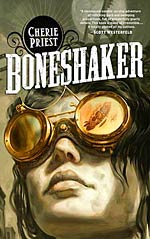
![]() ParallelWorlds
ParallelWorlds
9/2/2013
![]()
Intended Audience: Adult
Sexual content: None
Ace/Genderqueer characters: None
Rating: PG-13 for violence, gore, and language
Writing style: 1/5
Likable characters: 2/5
Plot/Concepts: 3/5
Leviticus "Levi" Blue was a genius who invented the Boneshaker, a massive drill intended for use in mining through glacial ice. Before it could ever be used, it tore beneath Seattle's streets and released a gas called the Blight which turns all who breathe it into zombies. Fifteen years later, Briar Wilkes, Levi's widow, works hard to support herself and her son Ezekiel, but when Zeke's questions about his father and grandfather go unanswered, he passes into the walled-off, Blight-tainted part of town to find answers for himself. Briar leaves everything behind to rescue her foolhardy son, hoping it's not too late to tell him the truth.
I was so excited to start this book. Seattle is my favorite city, and as I'm also fond of steampunk, I figured I was bound to like Boneshaker even if I'm not crazy about zombies. Reading the praises stamped on the cover and before the title page also built up my hopes. Unfortunately, before I'd gotten more than a few chapters in, my eyes began to glaze over with boredom and I found myself having to read paragraphs over again.
It's not that the events in the plot are boring—although the plot is a bit too straightforward, there is plenty of action, from dodging "rotters" to gunfights in tunnels and on rooftops, to airship battles and earthquakes. The writing style made it feel like a chore to wade through scenes which should have been gripping. Priest over-describes, gives too much information, tries too hard to unravel the logic of every single decision her characters make (even ones which should be made by impulse), lingers on meaningless unknowns, and seems addicted to overly dramatic one-sentence paragraphs. For example, instead of simply saying that Zeke was hit in the mouth by someone's elbow, she writes on page 122, "Rudy cuffed him across the mouth with something firm and bony wrapped in fabric—Zeke figured it was an elbow, but he couldn't see and he had to assume." I found myself repeatedly seized with the urge to grab a black marker and scribble out all the unnecessary and redundant sentences. Similarly on page 138, while Briar is creeping through the streets, Priest writes that all noise stopped, and then halfway down the page, writes "The noise stopped" again, even going so far as to describe how this absolute silence differed from the old absolute silence in Briar's mind. Logically, if a place is silent, the only thing which could make it more silent is if some unnoticed background noise disappeared, but Priest never makes that distinction.
I could go on and on about how much the writing style frustrated me, but that would make this review unnecessarily long. Suffice it to say that I struggled to finish this book at all, and ended up having to skim through most scenes by only reading the dialogue. I can only hope the author finds a better editor who will help her to grow out of these beginner's mistakes. She has fun ideas, so it's a shame they aren't put to paper in a way I can enjoy.
The characters were mostly unremarkable and I found it difficult to connect with any of them, although many of them seemed friendly enough. The background characters were all cut from the same cloth, from their accents to their gruff frontiersman exteriors which sometimes gave way to warm camaraderie. Briar is one of the only characters who shows any complexity. I did very much enjoy the fact that this book starred an older woman with no romantic subplot; her main concern is the safety of her son and her relationship with him. She also has a few secrets she is keeping, which are only revealed at the very end. Although her connection to her father and husband are treated as very important, she is a person in her own right and those connections are as much a hindrance as a help. Dr. Minnericht, the antagonist who rules the walled-in part of the city, had potential to be a much more interesting character than he was, but we only get glimpses of who he really is, as with everyone. Due to the lack of sexual/romantic themes in the book, many of the characters could easily be read as ace, but I doubt any of them were intended to be.
I had mixed feelings about the racial makeup of the cast as well. Seattle has always been a pretty diverse place, with white loggers and miners, native tribes, and the Chinese and other Asians who were welcome as laborers but not as citizens. Priest includes all three categories, and touches on the racial tensions which were most definitely present at the time, even having one white man kill a harmless Chinese man simply because he was Chinese. The one central American Indian character is called Princess Angeline, an old woman who walks around in white men's clothes (literally a man's outfit), throws knives and can shoot as well or better than any white man. I liked that she's capable and helpful but answers to no one. However the claim that she is a "princess" is never explained in any way, and felt like a trope thrown in just for fun.
On the whole, Boneshaker left me deeply unsatisfied on many levels. The setting had great potential since Priest's world-building is decent, but because of the writing style and weak characterization, the story wasn't able to shine as it could have.
http://www.parallelworldsmagazine.com